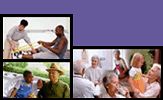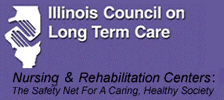|

March 8, 2000
Illinois Nursing Homes Take the Lead in Reducing
Falls
(Chicago) -- The Keiser Institute on Aging has released a report
that found that prevention methods can profoundly reduce
the risk of falling for the elderly, although fall risk
assessments are not widely administered to help prevent
"first" falls. While many community seniors
do not utilize risk assessments to reduce their risk
of falling, Illinois nursing facilities have taken the
lead in instituting fall prevention programs that have
been successful in reducing falls and increasing residents’
feelings of security, independence and well-being.
An estimated 10 to 17 million people
over 65 are expected to fall in 2000 and 30 percent
will experience moderate to severe injuries as a result.
Because of the life-threatening dangers of falls, the
Keiser Institute on Aging has designated March 6-10
as Fall Prevention
Week. Over 1,000 senior centers, retirement communities,
and nursing homes across the United States are sponsoring
a variety of activities this week to increase awareness
and access to vital assessment and fall prevention information.
The Illinois nursing home industry
has worked very hard to address the issue of fall prevention
in promoting resident safety and independence. In September
of 1997, the Illinois Council on Long Term Care, a health
care association representing over 200 nursing facilities
serving 35,000 Illinois nursing home residents, sent
its member facilities a standardized fall protocol developed
by industry experts. This policy was developed in cooperation
with the Illinois Department of Public Health and recommended
the following interventions:
·
Fall
Risk Assessment on every resident -- As part of
the Council protocol, every resident admitted into a
nursing facility receives a comprehensive fall risk
assessment that uncovers factors and combinations of
factors that need to be addressed on the resident care
plan. This assessment is over and above what is required
by federal and state regulations.
·
Fall
Investigation -- Every time a resident falls, staff
members complete a Fall Investigation Report that assesses
the details of the fall, causes of the fall, contributing
internal factors (medical conditions) and contributing
external factors (such as medications, appliances, and
environmental circumstances). The Fall Investigation
Report is used to determine whether additional or modified
care plan interventions are warranted because of the
most recent fall.
·
Incident
Report for Resident Falls with Injury -- An Incident
Report is completed in conjunction with the Fall Investigation
Report when the fall of the resident also resulted in
an injury, including bruises and skin tears.
The Council Fall Protocol has been
adopted by many Illinois nursing facilities and demonstrates
a good faith effort on the part of these facilities
to reduce and prevent falls.
The issue of fall prevention has
currently received a great deal of attention from both
nursing home providers and public health surveyors due
to the successful efforts of nursing homes to reduce
restraints. As of December of 1999, the restraint rate
in Illinois nursing homes is 6.9% (nationally, the restraint
rate is 12.09%). This rate is a dramatic decrease from
the year 1988, when 41% of residents nationwide were
in restraints.
A by-product to restraint reduction,
however, has been an increased risk of non-serious falls.
In response to this possibility of
increased falls, Illinois nursing homes have implemented
fall prevention programs that involve every staff member
in the facility. The fall prevention programs at Illinois
nursing facilities include the following components:
· A
multidisciplinary safety committee to develop and implement
an institution-wide fall prevention program. The
members are knowledgeable in the area of falls and include
one or more persons (e.g. Director of Nursing, Medical
Director, Rehab Director, Director of Quality Assurance,
etc.) who has the administrative authority to enact
or facilitate policy change. The safety committee evaluates
the facility environment overall for potential fall
risks.
· An
in-service nursing and medical house-staff education
program for all professionals involved in resident
care on the cause of falls, factors responsible for
fall risk, and appropriate preventive strategies. Nursing
education extends to staff on all three shifts.
·
A
mechanism to identify residents at fall risk immediately
upon admission and available for each nursing shift.
Fall risk is reassessed whenever an individual’s
medical condition, medication regimen and mobility status
changes. Identification tags (i.e. colored wrist identification
bands, colored adhesive stickers near the bedroom door
and bedside, on medical/nursing charts, etc.) are used
to alert staff to high-risk persons.
· Residents
are assessed immediately after a fall; they are evaluated
for underlying medical and environmental causes.
A formal program and policy for reporting and investigating
incident reports is in place.
·
Strategies
are implemented to prevent falls, and follow-up occurs
on a regular basis to review whether the designed interventions
have decreased falls. The success of a facility’s
fall prevention program is regularly assessed during
the facility’s quality improvement meetings.
Because there are so many factors
that can lead to falls, such as vision impairments,
dizziness, mobility problems, medications, and cognitive
deficits, preventing falls can be quite challenging.
“We look at many factors when assessing falls,”
states Diania Magafus, RN, nurse consultant for Dynamic
Healthcare. “Our interdisciplinary team evaluates
if we have done everything that possibly we can to adequately
identify risk factors and treat the residents. Sometimes
it’s hard to pinpoint exactly what led to a resident
falling.”
Oftentimes, the best interventions
for preventing falls come directly from the front-line
staff. “Our nurse aides, housekeepers, activity
assistants, and other front-line staff members know
our residents the best,” points out Donna Sprinkle,
MS, Quality Assurance Director of ManagCare. “We
solicit the advice of these staff members in developing
creative fall interventions. They often have the best
ideas of successful ways that we can reduce falls for
each individual resident’s unique circumstances.”
Among the strategies that have been
proven successful in reducing resident falls at Illinois
nursing homes have been:
· Identifying
residents at high risk for falling, including those
having poor vision, gait disturbances, weakness, cardiovascular
disease, incontinence, and a history of falls.
· Increasing
the sensitivity of the entire staff to the potential
for accidents within and around the facility through
ongoing education programs. Instructing each employee
to play a part in noticing, reporting, and reducing
potential hazards.
· Teaching
residents safe transfer techniques from bed, chairs,
toilet, and wheelchairs. Advising residents to change
positions slowly, holding on to a stable object as they
do.
· Utilizing
exercise as a means of improving resident strength,
balance, and coordination.
· Encouraging
volunteers and family members to assist with the monitoring
of residents at risk for falls.
· Having
the facility therapist evaluate residents for interventions
such as physical therapy, restorative programs, and
adaptive equipment such as positioning cushions or tilted
seats.
· Monitoring
medications; in particular minimizing the use of sedatives
and tranquilizers.
· Encouraging
residents to use handrails.
· Placing
residents at risk for falling in rooms near the nurse’s
station for easier observation.
·
Continuously assessing for environmental
hazards and eliminating as appropriate. Keeping floors
free from litter and clutter. Providing good lighting
in all resident areas. Cleaning spills immediately.
Maintaining beds at their lowest position and keeping
bed wheels locked at all times. Using a low profile
bed if needed.
· Assuring
that residents use canes, walkers, and wheelchairs only
when prescribed and that these aids are fitted to the
individual and are used correctly. Making sure to check
these mobility aids regularly to ensure they are in
good repair, as broken equipment can cause injury.
· Making
sure that residents wear well-fitted, low-heeled shoes;
preventing them from wearing long robes and pants that
fall below the ankle.
One of the most important components
of the fall prevention programs at Illinois nursing
homes is reviewing individual cases of resident falls
and examining trends during quality improvement meetings.
“Our safety committee carefully looks at the statistics
-- number of falls, time of the day for falls, staffing
patterns, locations of falls -- to draw accurate conclusions
about how we can enhance resident safety,” states
Barb Lupo, RN, Nurse Consultant for Family Care Management.
“Preventing falls requires a proactive approach
whereby staff members are continuously scrutinizing
various risk factors for falls and developing solutions
as part of a team approach to care.”
Through the development of fall prevention
programs, Illinois nursing facilities have been very
successful in enhancing resident safety, independence,
and outlook. As Terry Sullivan, executive director of
the Illinois Council on Long Term Care, explains, “Preventing
falls is a very serious challenge that impacts not only
on residents’ physical well-being, but also affects
their emotional status as well. Threats of impending
falls can alter a resident’s self-image and create
feelings of frailty and incompetence. Staff members
at Illinois nursing homes have focused on the issue
of fall prevention in their continuing efforts to maximize
resident wellness and quality of life.”
# # #
|

